
Students evaluate the Sine, Cosine, and Tangent ratios of a right triangle.
- Subject:
- Mathematics
- Numerical analysis
- Probability
- Trigonometry
- Date Added:
- 10/15/2010

Students evaluate the Sine, Cosine, and Tangent ratios of a right triangle.
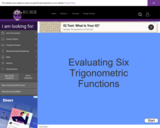
Students evaluate the six trig functions using a scientific calculator.

The learner factors an algebraic expression of the form AX(Squared) + BX + C, where the coefficient of the X squared term is not equal to 1.

In this interactive object, students work problems using the difference of two perfect squares.
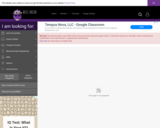
Students use trigonometry to find the coordinates of the blending point where a line and an arc meet. Learners are given the coordinates of the center of the arc, the radius of the arc, and the direction of the line.

This activity asks a student to use a scientific calculator to do numeric calculations and enter results in a crossword puzzle.
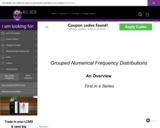
In this interactive object, students read about organizing data in a tabular form. A brief quiz completes the activity. This is the first in a series of six learning objects.

In this interactive object, learners read the definitions of terms associated with the construction of a grouped frequency distribution. A brief quiz completes the activity.

Learners follow steps to establish the lower and upper limits in a spreadsheet.

Students examine an Excel spreadsheet to determine range, class, and width.

Learners follow steps to establish class boundaries and tally the data using a spreadsheet.

Students follow step-by-step directions for entering data into a spreadsheet and reporting the results.

In this interactive object, the learner examines the terms associated with a grouped frequency distribution and follows the steps to construct a grouped frequency distribution using manual methods. Self-check exercises are included.

This learning object walks the student through an inverse variation problem.

This learning object walks the student through a joint variation problem.
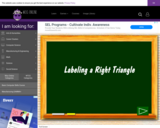
The learner identifies the sides of a right triangle with respect to the angles.

Students apply the Law of Sines in the solution on an oblique triangle when provided with two angles and the side opposite one of the angles.

The target audience of this learning object is trigonometry students who have already learned what a radian is and have already derived the key values of the coordinates associated with common radian units, but now need to practice finding those values on the unit circle. The student does not need to know the definition of the six trig functions to do this activity.

This activity provides instruction and practice problems on the multiplication of monomials.
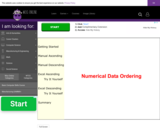
In this interactive object, learners read how to arrange numerical data manually by using ascending or descending order. They also practice arranging the data using a spreadsheet.